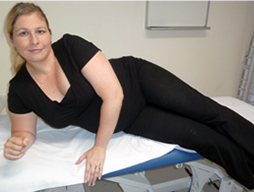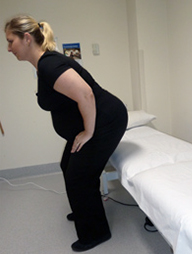Self-care after caesarean birth
A caesarean section is an abdominal surgery and it will take time for your uterine scar, muscles and tissue to heal.
It will take a minimum of 6 weeks for your uterine scar to regain at least half of its pre-surgery strength.
Your scar will continue to heal over the next 6 – 7 months, so it is important to ease back into exercise. Follow these steps in the few days to weeks after your caesarean birth to assist recovery.
Getting out of bed
After your delivery, your abdominal muscles will have stretched, especially if you have had a caesarean delivery. The following tips can help these muscles recover.
|
Roll onto your side
|
 |
||
Standing up
Reverse this routine to get back into bed. |
 |
||
Support yourself when you cough, sneeze or laugh
To protect your wound and help you feel better, follow these steps every time you need to cough, sneeze or laugh.
- Cover your wound with a pillow, folded towel or your hands.
- Support/hold on to your stomach with your hands while coughing, sneezing or laughing.
Exercises
These exercises can also help your recovery while you are not moving as much as you would normally.
Focus on your breathing
- Relax your shoulders and upper chest.
- Place your hands on your lower stomach.
- Breathe in as deeply as you can into your hands to feel your belly rise.
Do 3 of these breaths every half hour while resting in bed.
Ankle pump
- Point and flex your toes 10 times.
- Move your ankles in circles, 10 times in each direction.
- Do this every half hour to maintain good circulation while you are resting in bed.
Make time to rest
Try to rest on your bed even for short periods during the day. For example, once you have put down your baby for a sleep, try and go for a sleep too.
Avoid heavy lifting
Do not lift anything heavier than your new baby for 6–8 weeks.
If you need to hold your breath in order to lift the load it is too heavy.
Ask others to help you lift:
- loads of wet washing
- toddlers
- shopping bags
- baby baths
- baby capsules and prams
- full pots of water on and off the stove.
Returning to driving
Generally, you may not drive for 4 to 6 weeks, however this is subject to your doctor’s advice and may vary. Please note your insurance coverage depends on the medical advice you have been given.
To drive safely, you must be able to perform the following without pain:
- push the pedals
- turn to look over your shoulder to check your blind spots
- turn the steering wheel
- push firmly on the brakes as if you had to stop suddenly in an emergency.
Start general fitness activities
Ease into activity gradually. Refer to the safe return to exercise program.
Listen to your body and stay safe
If you feel tired or your wound aches, your body is telling you to rest.
Initially (but not as soon as you get home from the hospital) start with light housework such as washing dishes, preparing a meal, light hand washing and dusting.
You may reach, stretch and walk up and down the steps.
More information
Find out more about physiotherapy after pregnancy, caring for you after birth, or return to the Maternity page.

